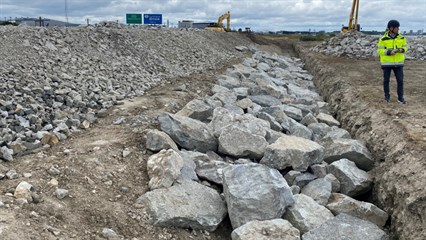Storm-surge protection of the Øresund link consists almost exclusively of passive flood controls.
In addition to the dikes, several other controls will be introduced.
The four-kilometre-long underground tunnel starts at Kastrup on Amager and ends on the artificial island of Peberholm.
From Peberholm and for the remainder of the stretch to Sweden, the link continues as a bridge.
All of the storm-surge projects pertain to the tunnel and are on Amager and Peberholm.
Two large dikes will be established. The longest 900-meter-long dike will be on the Kastrup peninsula and will protect the road leading down into the tunnel.
The dike will be established during autumn 2022 and will provide an additional three-metre-high protection against the sea.
The other large dike will be 800 meters long and will be established on Peberholm. Together with a 400-meter-long concrete wall, this dike will secure the road where it runs up onto the island from the tunnel.
Several smaller dikes will be established on the four-kilometre-long, and 160-hectare island of Peberholm . These will secure technical instillations as well as road and railway traffic.
The dikes consist of various material fractions with a core of clay.
The longest dike on the Kastrup peninsula alone will require 10,000 cubic metres of rocks and boulders laid on the outer surface of the dike to protect it against erosion. The rocks will be retrieved from quarries in Skåne, Sweden.

The dikes on Peberholm will largely be built using material dug up on the island itself.
Peberholm consists of dredged seabed material, and since it was established more than 20 years ago, the island has developed its own ecosystem, with around 400 plant species, 30 bird species and more than 500 species of insect.
Using material from the island itself for the dikes will spare the ecosystem from unnecessary disturbances.
Climate projections will continue to change over time. The future will bring new risk assessments identifying new needs.
Øresundsbro Konsortiet has therefore designed the current storm surge projects with built-in flexibility so that the projects can be reinforced in the years to come.
Furthermore, as part of the projects up to 2025, Øresund Konsortiet will carry out risk analyses and preliminary studies to assess how the groundwater affects
ramps, railway embankments and toll booths.